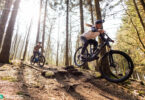E-Mountainbike Grouptest: Ten E-Mountainbikes Review

In the last year, more and more new models have flooded into the e-mountain bike sector. Unfortunately, not all of them have well thought-out concepts, suspensions, or drive systems. Thoughtlessly equipped bikes are just as common as highly engineered and well-conceived machines which have been constructed from the ground up for this type of use.
Update (November 2015)
In this group test from September 2014 we tested the most exciting E-mountain bikes of the 2015 model year. In the meantime, a lot has happened on the market and the manufacturers have introduced new bikes for the 2016 season. If you are currently looking for an E-mountain bike, we suggest to take a look at our current group test of nine 2016 E-Mountain bikes.

For our comprehensive debut group-test, our aim was to deliver clear and ordered points of reference for those thinking of buying an E-MTB. What makes sense, and what is completely senseless? Our team of experienced professional riders, engineers, bike guides and lay people set out answer these questions without shying away from cost and effort.
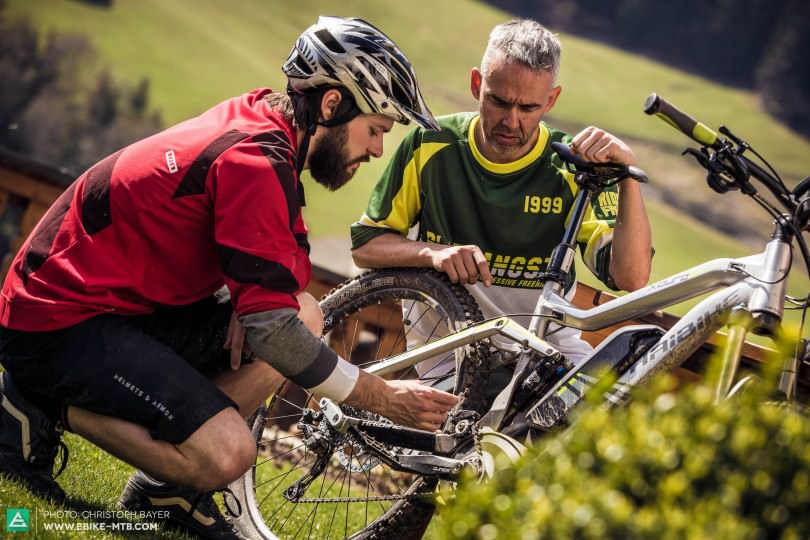
We invited ten of the most interesting e-mountain bikes to take part in the test. The machines in the test group ranged from hardtails with suspension forks to potent full-suspension bikes with 160mm of travel. We found a perfect place to put the bikes through their paces in the South Tyrol – dream weather, amazing trails, and endless climbs and descents made for a worthy backdrop for this test of superlatives.
At the beginning there‘s a simple question: what makes a good e-mountainbike? ?
Is it the motor? After all, it provides the extra power and everyone can feel it clearly whilst riding. Within the test group, three different drive concepts were represented. Alongside the Bosch Performance drive fitted to most test models, the Giant Full-E uses a Yamaha SyncDrive C-System, and the Focus Thron is equipped with an Impuls-II Sport motor.

Whilst the Yamaha motor has the highest power output with 250 W continuous and 600 W peak output (combined with 60 Nm torque), the Bosch motor delivers the great all-round performance we‘ve become accustomed to and is especially impressive in its constant power delivery. But the Impulse-II drive is also a solid performer with well-thought-out details such as the Shift-Sensor, which momentarily interrupts the power supply during shifting, thus sparing the chain, cassette, and rear derailleur from excessive wear.
With the Impulse-II the power delivery is also more sensitive to the rider‘s pedaling, so initially climbing performance can decrease if you have a lumpy pedaling style. After we got used to the system, we found it posed no problems.
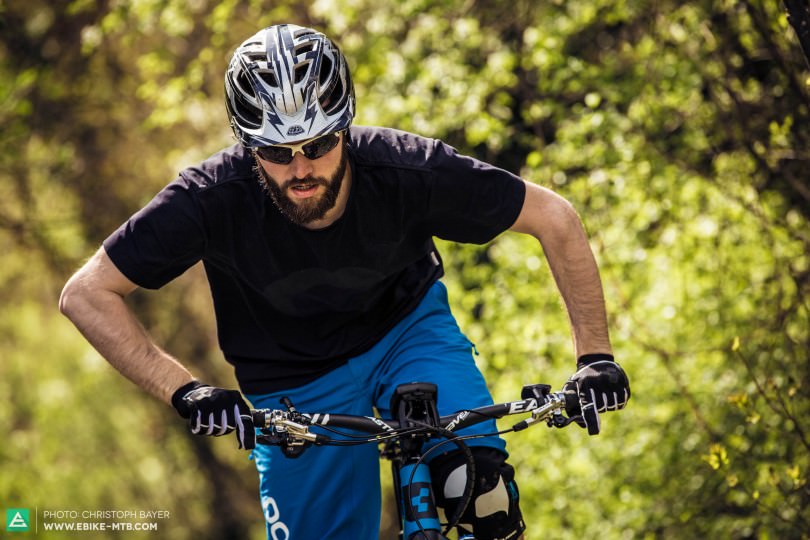
At the end of the day each system delivers a well-functioning and reliable product. One thing they all have in common is the weight centered around the bottom bracket. This gives the bike a good, low center of gravity without affecting weight distribution. This is why mid-mounted motors are the best drive system for e-mountain bikes: front or rear motors are absolutely not useable off-road. This factor is decisive for the bike handling when descending. The motor still plays a big part but isn‘t the overriding factor which gives the bike its character.
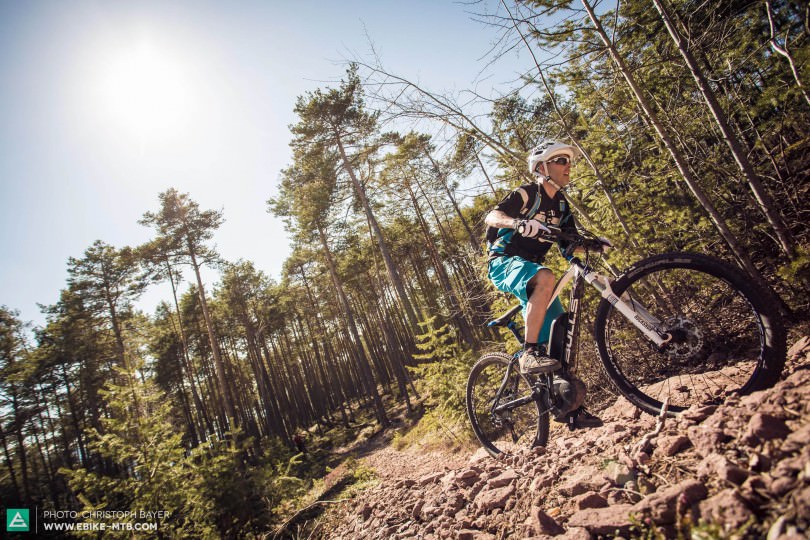
Often a chassis will be a combination of both systems, meaning the suspension is very linear but firms up at the end of the travel. There is no good or bad, as what counts is the overall concept and the personal preferences of the rider. The weight of e-mountain bikes plays a lesser role compared to typical bikes, as a powerful motor negates the extra mass.
Riding uphill other factors are also decisive, above all the geometry and the resulting rider position on the bike. Over the last years much has changed in mountain bike geometry. The feeling that you pedal from behind the bike has been eliminated. Almost every bike in the test group has a seat tube angle of 73° or steeper. Other critical factors for bike handling are (amongst others) the chainstay length, head tube angle, wheelbase, and top tube length.
Together they create the character of a bike. A slack head tube angle (67.5°) – as on the Giant Full-E+0 and the Cube Stereo Hybrid 140SL 27.5 – brings stability and confidence on downhills. Short 450-mm chainstays, as on the Kreidler Las Vegas and Focus Thron Impulse, create great agility. However, you can‘t read bike handling characteristics from a sheet of paper, as the individual factors are so interdependent. A thorough test as we have carried out is the only way to really see how a bike performs.
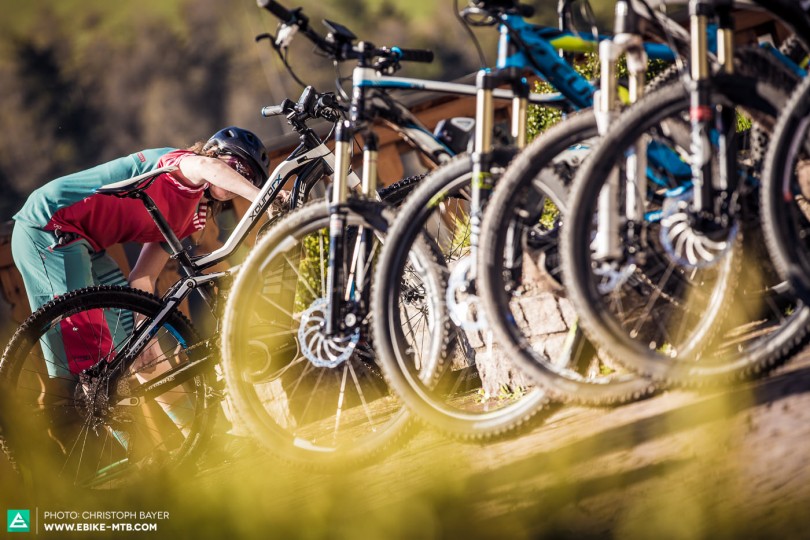
The fact that the overall weight of the whole test field varies by only 8% in spite of wildly different spec levels and suspension travel is noteworthy. The bikes range from 20.15kg to 21.75kg – none of them crack the magic 20kg border. But here it needs to be said that a different measuring stick needs to be applied for e-mountainbikes. Riding uphill the motor saves an enormous amount of effort, so the varying weights are hardly noticeable (and as mentioned the lion‘s share of it is positioned low and central on the bike).
In this regard, ride characteristics are only marginally affected by overall weight and can be felt most easily in terms of handling. The rule of thumb „minimum weight = maximum fun“ doesn‘t work with e-mountain bikes.

Which brings us to specs: they are just as important with motorised bikes. It doesn‘t really matter whether a high-end rear mech or carbon cranks are fitted, but whether the overall concept is suitable for the intended use and available travel of the bike. Weight plays a lesser role, and function is what counts. The added weight of a dropper seatpost or grippy tires can be ignored, as the performance increase needs to be a priority – for every bike! A well thought-out cockpit with a short stem (less than 90mm length) and a wide bar (720mm-plus wide) can increase the rider‘s fun enormously. Long stems (120mm), rigid seatposts, under-dimensioned brakes and semi-slick tyres held back the capabilities of otherwise potent bikes.

In general, the standards and priorities applied to normal mountainbikes need to be completely re-defined for their electrified versions.
For decades mountainbikes have been trimmed for efficiency in order to transform every available „watt“ of leg power. Pedal-optimised geometries, super-efficient suspension with lockout functions for dampers, and the lowest possible weight became a means to an end. Tires and components have been conceived for minimum weight, and numerous different bike categories invented with different amounts of travel and strength. With e-mountainbikes new priorities come to the fore: suspension travel no longer has such an influence on the efficiency an e-mountainbiker needs. Strength, security, and reliability become the foundations of a rider‘s enjoyment.
All Bikes in an overview
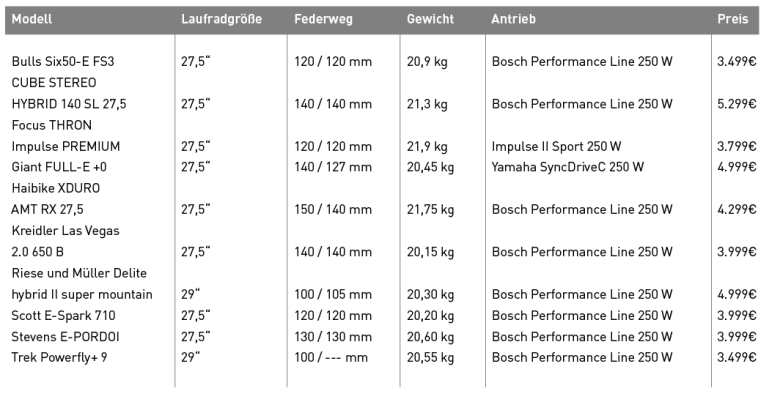

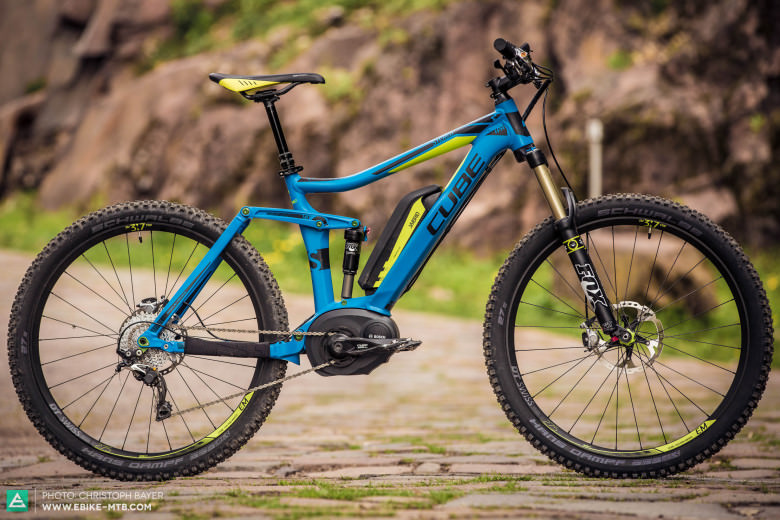
Cube Stereo Hybrid 140 SL 27,5
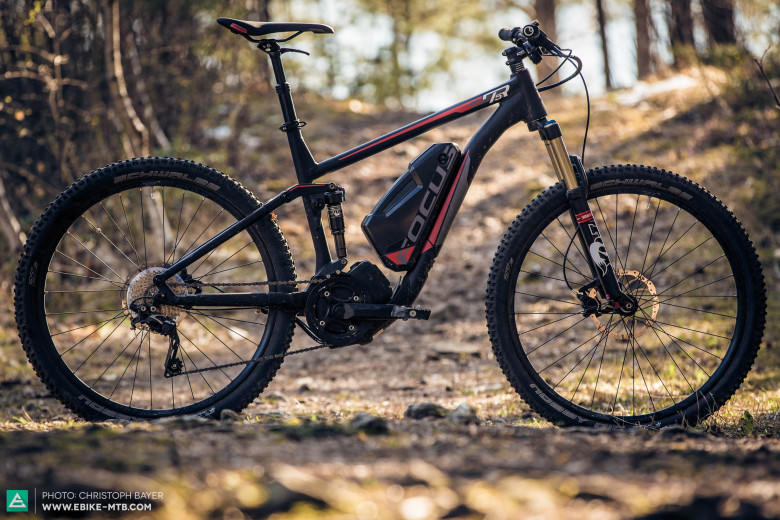
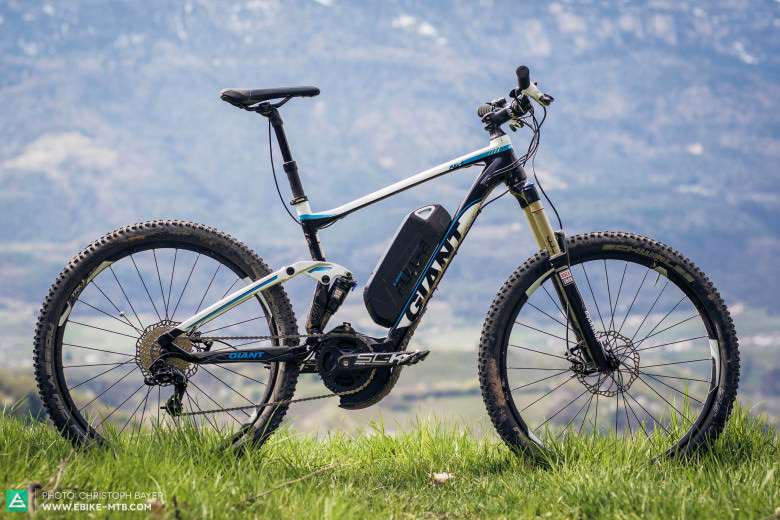
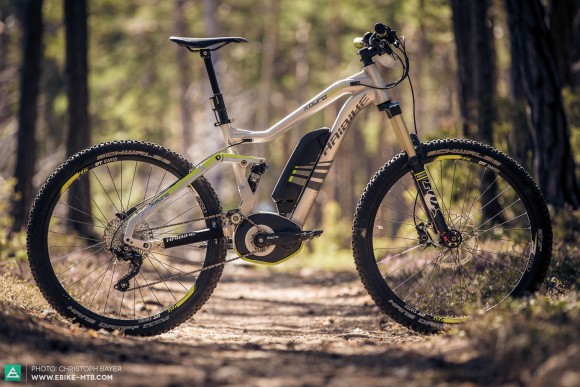


Riese und Müller Delite Hybrid II

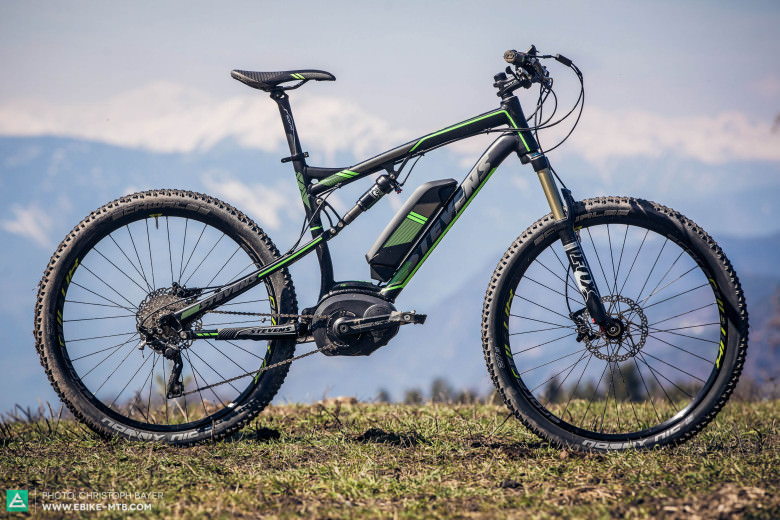
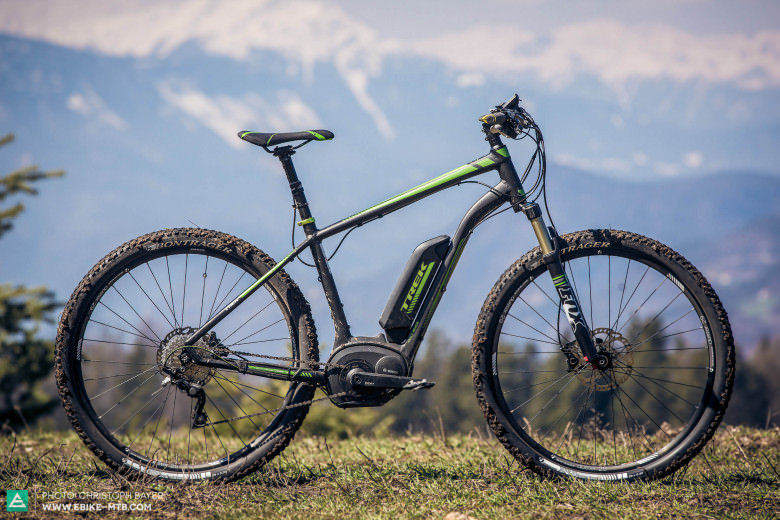
CONCLUSION
Many manufacturers like Kreidler, Stevens, Scott, and Riese & Müller fulfill all of the test team‘s criteria but still don‘t quite convince us across the board. The Cube Stereo Hybrid 140 SL 27.5, Haibike XDURO AMT RX 27.5, Giant Full-E+ 0 and the Focus Thron Impulse won us over completely. These are the bikes which are able to stand above the rest thanks to their capable suspension, well-rounded geometries, and weight-adjusted component specs.
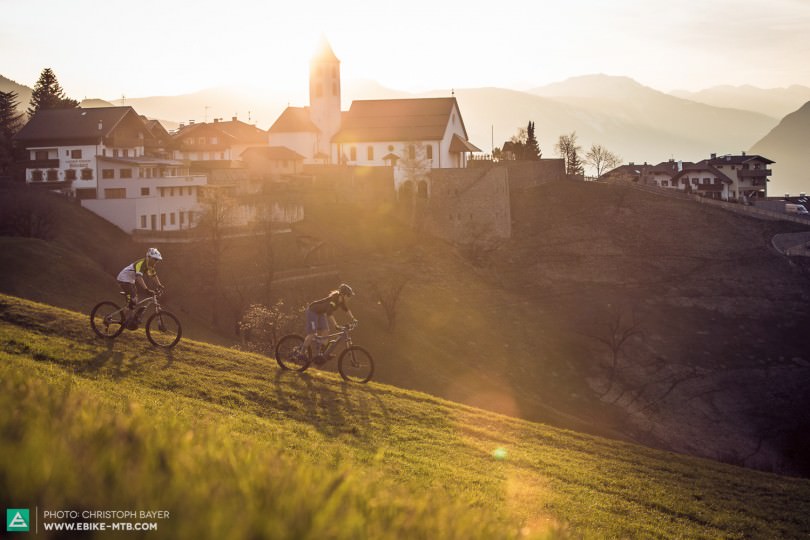
However, there‘s still plenty to do: some quite basic things, such as the highly exposed displays fitted to every bike, are not yet suitable to hard off-road riding. The future will surely stay electrifying with the next competitors and new products already waiting in the wings (e.g. Rotwild cooperating with the motor producer Borse). This competition and the new products it brings will help develop the market and nurture innovation.
The trip has just started – we’re on board and pioneering the way! We can’t wait for the next developments.
Text: Christoph Bayer / Robin Schmitt Photo: Christoph Bayer
Did you enjoy this article? If so, we would be stoked if you decide to support us with a monthly contribution. By becoming a supporter of E-MOUNTAINBIKE, you will help secure a sustainable future for high-quality cycling journalism. Click here to learn more.





